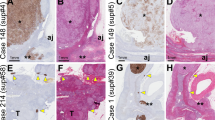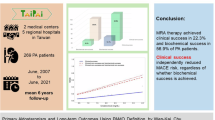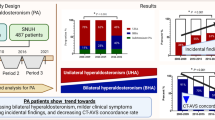Abstract
Primary aldosteronism (PA) caused by aldosterone hypersecretion is treated by adrenalectomy or medications. Histopathologic examination of resected adrenals reveals diverse histopathologic features. This study aimed to investigate the potential association of peripheral and adrenal tissue metabolic profiles with the histopathologic features of PA. The retrospective study included 105 surgically treated and 43 medically treated patients with PA. Adrenal specimens were categorized according to the HISTALDO (HISTopathology of primary ALDOsteronism) consensus. Peripheral and adrenal tissue metabolic profiles were assessed, including adiposity, adipokines and fatty acid abundances. The distinct fatty acid, arachidonic acid, was further functionally characterized. Surgically treated patients with classical histopathologic findings (n = 71) displayed lower body mass indexes, a lower prevalence of obesity, smaller waist circumference and visceral adipose tissue areas, and lower leptin concentrations compared with operated patients with the nonclassical histopathology (n = 34). No such differences were identified between the nonclassical histopathology group and medically treated group. Distinct concentrations of 18 out of 35 peripheral venous fatty acids, including arachidonic acid, were identified among the 3 groups. Further, accumulation of arachidonic acid was demonstrated in 4 aldosterone-producing adenomas compared with paired adjacent cortex possibly linked with suppressed peroxisomal beta-oxidation. Stimulation of human adrenocortical cells with arachidonic acid or peroxisomal beta-oxidation inhibitor caused 3.8-fold (P = 0.0050) and 1.7-fold (P = 0.0328) amplification of CYP11B2 expression, respectively, which were ablated by BAPTA-AM or KN93, and induced oxidative stress and apoptosis. Our findings show metabolic heterogeneity related to histopathology and support a role for arachidonic acid in PA pathophysiology.

This is a preview of subscription content, access via your institution
Access options
Subscribe to this journal
Receive 12 print issues and online access
$259.00 per year
only $21.58 per issue
Buy this article
- Purchase on SpringerLink
- Instant access to full article PDF
Prices may be subject to local taxes which are calculated during checkout




Similar content being viewed by others
Data availability
The raw data supporting the conclusions of the article will be made available on reasonable request by the corresponding authors.
References
Funder JW, Carey RM, Mantero F, Murad MH, Reincke M, Shibata H, et al. The management of primary aldosteronism: case detection, diagnosis, and treatment: an Endocrine Society clinical practice guideline. J Clin Endocrinol Metab. 2016;101:1889–916.
Yang Y, Reincke M, Williams TA. Prevalence, diagnosis and outcomes of treatment for primary aldosteronism. Best Pract Res Clin Endocrinol Metab. 2020;34:101365.
Williams TA, Reincke M. Pathophysiology and histopathology of primary aldosteronism. Trends Endocrinol Metab. 2022;33:36–49.
Williams TA, Gomez-Sanchez CE, Rainey WE, Giordano TJ, Lam AK, Marker A, et al. International histopathology consensus for unilateral primary aldosteronism. J Clin Endocrinol Metab. 2021;106:42–54.
Omata K, Satoh F, Morimoto R, Ito S, Yamazaki Y, Nakamura Y, et al. Cellular and genetic causes of idiopathic hyperaldosteronism. Hypertension. 2018;72:874–80.
Williams TA, Gong S, Tsurutani Y, Tezuka Y, Thuzar M, Burrello J, et al. Adrenal surgery for bilateral primary aldosteronism: an international retrospective cohort study. Lancet Diabetes Endocrinol. 2022;10:769–71.
Ohno Y, Sone M, Inagaki N, Yamasaki T, Ogawa O, Takeda Y, et al. Obesity as a key factor underlying idiopathic hyperaldosteronism. J Clin Endocrinol Metab. 2018;103:4456–64.
Akehi Y, Yanase T, Motonaga R, Umakoshi H, Tsuiki M, Takeda Y, et al. High prevalence of diabetes in patients with primary aldosteronism (PA) associated with subclinical hypercortisolism and prediabetes more prevalent in bilateral than unilateral PA: a large, multicenter cohort study in Japan. Diabetes Care. 2019;42:938–45.
Spyroglou A, Handgriff L, Muller L, Schwarzlmuller P, Parasiliti-Caprino M, Fuss CT, et al. The metabolic phenotype of patients with primary aldosteronism: impact of subtype and sex - a multicenter-study of 3566 Caucasian and Asian subjects. Eur J Endocrinol. 2022;187:361–72.
Eisinger K, Liebisch G, Schmitz G, Aslanidis C, Krautbauer S, Buechler C. Lipidomic analysis of serum from high fat diet induced obese mice. Int J Mol Sci. 2014;15:2991–3002.
Chouchani ET, Kajimura S. Metabolic adaptation and maladaptation in adipose tissue. Nat Metab. 2019;1:189–200.
Hodson L, Gunn PJ. The regulation of hepatic fatty acid synthesis and partitioning: the effect of nutritional state. Nat Rev Endocrinol. 2019;15:689–700.
Witt A, Mateska I, Palladini A, Sinha A, Wolk M, Harauma A, et al. Fatty acid desaturase 2 determines the lipidomic landscape and steroidogenic function of the adrenal gland. Sci Adv. 2023;9:eadf6710.
Meyer LS, Wang X, Susnik E, Burrello J, Burrello A, Castellano I, et al. Immunohistopathology and steroid profiles associated with biochemical outcomes after adrenalectomy for unilateral primary aldosteronism. Hypertension. 2018;72:650–57.
Meyer LS, Handgriff L, Lim JS, Udager AM, Kinker IS, Ladurner R, et al. Single-center prospective cohort study on the histopathology, genotype, and postsurgical outcomes of patients with primary aldosteronism. Hypertension. 2021;78:738–46.
Gong S, Sun N, Meyer LS, Tetti M, Koupourtidou C, Krebs S, et al. Primary aldosteronism: spatial multiomics mapping of genotype-dependent heterogeneity and tumor expansion of aldosterone-producing adenomas. Hypertension. 2023;80:1555–67.
Williams TA, Lenders JWM, Mulatero P, Burrello J, Rottenkolber M, Adolf C, et al. Outcomes after adrenalectomy for unilateral primary aldosteronism: an international consensus on outcome measures and analysis of remission rates in an international cohort. Lancet Diabetes Endocrinol. 2017;5:689–99.
Kobayashi H, Abe M, Soma M, Takeda Y, Kurihara I, Itoh H, et al. Development and validation of subtype prediction scores for the workup of primary aldosteronism. J Hypertens. 2018;36:2269–76.
Zhang Z, Song B, Wei H, Liu Y, Zhang W, Yang Y, et al. NDRG1 overcomes resistance to immunotherapy of pancreatic ductal adenocarcinoma through inhibiting ATG9A-dependent degradation of MHC-1. Drug Resist Updat. 2024;73:101040.
Gomez-Perez SL, Haus JM, Sheean P, Patel B, Mar W, Chaudhry V, et al. Measuring abdominal circumference and skeletal muscle from a single cross-sectional computed tomography image: a step-by-step guide for clinicians using national institutes of health imageJ. JPEN J Parenter Enteral Nutr. 2016;40:308–18.
Williams TA, Monticone S, Schack VR, Stindl J, Burrello J, Buffolo F, et al. Somatic ATP1A1, ATP2B3, and KCNJ5 mutations in aldosterone-producing adenomas. Hypertension. 2014;63:188–95.
Ling G, Bruno J, Albert SG, Dhindsa S. Fatty acids as a direct regulator of aldosterone hypersecretion. Mol Cell Endocrino. 2023;561:111836.
Gong S, Tetti M, Reincke M, Williams TA. Primary aldosteronism: metabolic reprogramming and the pathogenesis of aldosterone-producing adenomas. Cancers. 2021;13:3716.
Carracedo A, Cantley LC, Pandolfi PP. Cancer metabolism: fatty acid oxidation in the limelight. Nat Rev Cancer. 2013;13:227–32.
Hanna VS, Hafez EAA. Synopsis of arachidonic acid metabolism: a review. J Adv Res. 2018;11:23–32.
Zalckvar E, Schuldiner M. Beyond rare disorders: a new era for peroxisomal pathophysiology. Mol Cell. 2022;82:2228–35.
Kamijo K, Taketani S, Yokota S, Osumi T, Hashimoto T. The 70-kDa peroxisomal membrane protein is a member of the Mdr (P-glycoprotein)-related ATP-binding protein superfamily. J Biol Chem. 1990;265:4534–40.
Van den Branden C, Roels F. Thioridazine: a selective inhibitor of peroxisomal beta-oxidation in vivo. FEBS Lett. 1985;187:331–3.
Matrozova J, Steichen O, Amar L, Zacharieva S, Jeunemaitre X, Plouin PF. Fasting plasma glucose and serum lipids in patients with primary aldosteronism: a controlled cross-sectional study. Hypertension. 2009;53:605–10.
Somloova Z, Widimsky J Jr, Rosa J, Wichterle D, Strauch B, Petrak O, et al. The prevalence of metabolic syndrome and its components in two main types of primary aldosteronism. J Hum Hypertens. 2010;24:625–30.
Karpe F, Dickmann JR, Frayn KN. Fatty acids, obesity, and insulin resistance: time for a reevaluation. Diabetes. 2011;60:2441–9.
Antraco VJ, Hirata BKS, de Jesus Simao J, Cruz MM, da Silva VS, da Cunha de Sa RDC, et al. Omega-3 polyunsaturated fatty acids prevent nonalcoholic steatohepatitis (NASH) and stimulate adipogenesis. Nutrients. 2021;13:622.
Murakami M, Rhayem Y, Kunzke T, Sun N, Feuchtinger A, Ludwig P, et al. In situ metabolomics of aldosterone-producing adenomas. JCI Insight. 2019;4:e130356.
Wang W, Hao X, Han L, Yan Z, Shen W-J, Dong D, et al. Tissue-specific ablation of ACSL4 results in disturbed steroidogenesis. Endocrinology. 2019;160:2517–28.
Yamazaki Y, Omata K, Tezuka Y, Ono Y, Morimoto R, Adachi Y, et al. Tumor cell subtypes based on the intracellular hormonal activity in KCNJ5-mutated aldosterone-producing adenoma. Hypertension. 2018;72:632–40.
Murakami M, Sun N, Li F, Feuchtinger A, Gomez-Sanchez C, Fassnacht M, et al. In situ metabolomics of cortisol-producing adenomas. Clin Chem. 2023;69:149–59.
Hac-Wydro K, Wydro P. The influence of fatty acids on model cholesterol/phospholipid membranes. Chem Phys Lipids. 2007;150:66–81.
Holthuis JC, Menon AK. Lipid landscapes and pipelines in membrane homeostasis. Nature. 2014;510:48–57.
Fan W, Evans RM. Turning up the heat on membrane fluidity. Cell. 2015;161:962–3.
Issop L, Rone MB, Papadopoulos V. Organelle plasticity and interactions in cholesterol transport and steroid biosynthesis. Mol Cell Endocrinol. 2013;371:34–46.
Spaulding SC, Bollag WB. The role of lipid second messengers in aldosterone synthesis and secretion. J Lipid Res. 2022;63:100191.
Sun N, Wu Y, Nanba K, Sbiera S, Kircher S, Kunzke T, et al. High-resolution tissue mass spectrometry imaging reveals a refined functional anatomy of the human adult adrenal gland. Endocrinology. 2018;159:1511–24.
Weigand I, Schreiner J, Röhrig F, Sun N, Landwehr L-S, Urlaub H, et al. Active steroid hormone synthesis renders adrenocortical cells highly susceptible to type II ferroptosis induction. Cell Death Dis. 2020;11:192.
Duarte A, Castillo AF, Castilla R, Maloberti P, Paz C, Podesta EJ, et al. An arachidonic acid generation/export system involved in the regulation of cholesterol transport in mitochondria of steroidogenic cells. FEBS Lett. 2007;581:4023–8.
Mele PG, Duarte A, Paz C, Capponi A, Podesta EJ. Role of intramitochondrial arachidonic acid and acyl-CoA synthetase 4 in angiotensin II-regulated aldosterone synthesis in NCI-H295R adrenocortical cell line. Endocrinology. 2012;153:3284–94.
Zhang Y, Liu Y, Sun J, Zhang W, Guo Z, Ma Q. Arachidonic acid metabolism in health and disease. MedComm (2020). 2023;4:e363.
Stern N, Yanagawa N, Saito F, Hori M, Natarajan R, Nadler J, et al. Potential role of 12 hydroxyeicosatetraenoic acid in angiotensin II-induced calcium signal in rat glomerulosa cells. Endocrinology. 1993;133:843–7.
Yang Y, Gomez-Sanchez CE, Jaquin D, Aristizabal Prada ET, Meyer LS, Knösel T, et al. Primary aldosteronism: KCNJ5 mutations and adrenocortical cell growth. Hypertension. 2019;74:809–16.
Yang Y, Tetti M, Vohra T, Adolf C, Seissler J, Hristov M, et al. BEX1 is differentially expressed in aldosterone-producing adenomas and protects human adrenocortical cells from ferroptosis. Hypertension. 2021;77:1647–58.
Xie X, Wang X, Mick GJ, Kabarowski JH, Wilson LS, Barnes S, et al. Effect of n-3 and n-6 polyunsaturated fatty acids on microsomal P450 steroidogenic enzyme activities and in vitro cortisol production in adrenal tissue from yorkshire boars. Endocrinology. 2016;157:1512–21.
Maillard V, Desmarchais A, Durcin M, Uzbekova S, Elis S. Docosahexaenoic acid (DHA) effects on proliferation and steroidogenesis of bovine granulosa cells. Reprod Biol Endocrinol. 2018;16:40.
Mah CY, Nguyen ADT, Niijima T, Helm M, Dehairs J, Ryan FJ, et al. Peroxisomal beta-oxidation enzyme, DECR2, regulates lipid metabolism and promotes treatment resistance in advanced prostate cancer. Br J Cancer. 2024;130:741–54.
Ding L, Sun W, Balaz M, He A, Klug M, Wieland S, et al. Peroxisomal beta-oxidation acts as a sensor for intracellular fatty acids and regulates lipolysis. Nat Metab. 2021;3:1648–61.
Turcu AF, Tezuka Y, Lim JS, Salman Z, Sehgal K, Liu H, et al. Multifocal, asymmetric bilateral primary aldosteronism cannot be excluded by strong adrenal vein sampling lateralization: an international retrospective cohort study. Hypertension. 2024;81:604–13.
Acknowledgements
We are grateful to Heng Chen (Department of Endocrinology, The First Affiliated Hospital of Nanjing Medical University) for assistance with immunoassay measurements.
Funding
The author(s) declare financial support was received for the research, authorship, and/or publication of this article. This work was supported by the National Natural Science Foundation of China [grant number 82300887, 82203330]; the Natural Science Foundation of Jiangsu Province [grant number BK20220717]; the China Postdoctoral Science Foundation [grant number 2022TQ0132, 2022M711589].
Author information
Authors and Affiliations
Corresponding authors
Ethics declarations
Conflict of interest
The authors declare no competing interests.
Ethics approval
The studies involving humans were approved by The First Affiliated Hospital With Nanjing Medical University, Nanjing, China (approval number 2018-SR-375). The studies were conducted in accordance with the local legislation and institutional requirements.
Informed consent
All patients gave written informed consent for the use of clinical data and biomaterials.
Additional information
Publisher’s note Springer Nature remains neutral with regard to jurisdictional claims in published maps and institutional affiliations.
Supplementary information
Rights and permissions
Springer Nature or its licensor (e.g. a society or other partner) holds exclusive rights to this article under a publishing agreement with the author(s) or other rightsholder(s); author self-archiving of the accepted manuscript version of this article is solely governed by the terms of such publishing agreement and applicable law.
About this article
Cite this article
Yang, Y., Liu, Y., Williams, T.A. et al. Metabolic phenotypes and fatty acid profiles associated with histopathology of primary aldosteronism. Hypertens Res 48, 1363–1378 (2025). https://doi.org/10.1038/s41440-025-02143-w
Received:
Revised:
Accepted:
Published:
Issue date:
DOI: https://doi.org/10.1038/s41440-025-02143-w
Keywords
This article is cited by
-
Fatty acid profiles in aldosterone-producing adenoma: insights into pathogenetic significance
Hypertension Research (2025)



